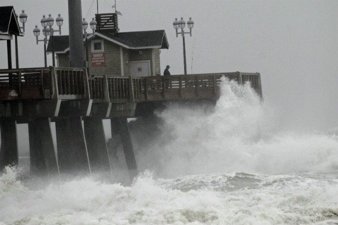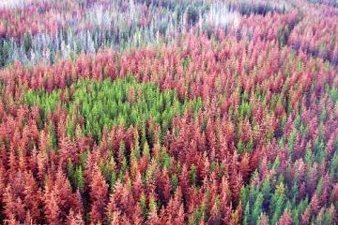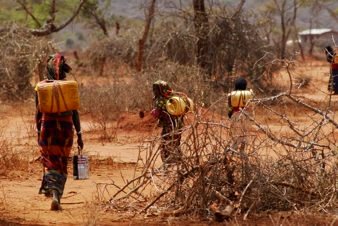- Hawaii and Pacific Islands
The U.S. Pacific Islands region includes more than 2,000 islands spanning millions of square miles of ocean. Rising air and ocean temperatures, shifting rainfall patterns, changing frequencies and intensities of storms and droughts, decreasing streamflows, rising sea levels, and changing ocean chemistry will threaten the sustainability of globally important and diverse ecosystems… as well as local communities, livelihoods, and cultures. Increasingly constrained freshwater supplies, coupled with increased temperatures, stress both people and ecosystems and decrease food and water security.

- Coasts
More than 50% of Americans – 164 million people – live in coastal counties, with 1.2 million added each year… Humans have heavily altered the coastal environment through development, changes in land use, and overexploitation of resources. Now, the changing climate is imposing additional stresses… Coastal lifelines, such as water supply infrastructure and evacuation routes are increasingly vulnerable to higher sea levels and storm surges, inland flooding, and other climate-related changes.
Climate-Change Impacts on Key Sectors of Society and the U.S. Economy
- Health: Climate change threatens human health and wellbeing in many ways, including through impacts from increased extreme weather events, wildfires, decreased air quality, threats to mental health, and illnesses transmitted by food, water, and disease carriers such as mosquitoes and ticks. Some of these health impacts are already underway in the United States. Climate change will, absent other changes, amplify some of the existing health threats the nation now faces. Certain people and communities are especially vulnerable, including children, the elderly, the sick, the poor, and some communities of colour. Public health actions, especially preparedness and prevention, can do much to protect people from some of the impacts of climate change. Early action provides the largest health benefits.
- Transportation: The impacts from sea level rise and storm surge, extreme weather events, higher temperatures and heatwaves, precipitation changes, Arctic warming, and other climatic conditions are affecting the reliability and capacity of the U.S. transportation system in many ways. Sea level rise, coupled with storm surge, will continue to increase the risk of major coastal impacts on transportation infrastructure, including both temporary and permanent flooding of airports, ports and harbours, roads, rail lines, tunnels, and bridges. Extreme weather events currently disrupt transportation networks in all areas of the country; projections indicate that such disruptions will increase. Climate change impacts will increase the total costs to the nation’s transportation systems and their users, but these impacts can be reduced through rerouting, mode change, and a wide range of adaptive actions.
- Energy: Extreme weather events are affecting energy production and delivery facilities, causing supply disruptions of varying lengths and magnitudes, and affecting other infrastructure that depends on energy supply. The frequency and intensity of certain types of extreme weather events are expected to change. Higher summer temperatures will increase electricity use, causing higher summer peak loads, while warmer winters will decrease energy demands for heating. Net electricity use is projected to increase. Changes in water availability, both episodic and long-lasting, will constrain different forms of energy production. In the longer term, sea level rise, extreme storm surge events, and high tides will affect coastal facilities and infrastructure on which many energy systems, markets, and consumers depend. As new investments in energy technologies occur, future energy systems will differ from today’s in uncertain ways. Depending on the character of changes in the energy mix, climate change will introduce new risks as well as new opportunities.
- Water: Climate change affects water demand and the ways water is used within and across regions and economic sectors. The Southwest, Great Plains, and Southeast are particularly vulnerable to changes in water supply and demand. Changes in precipitation and runoff, combined with changes in consumption and withdrawal, have reduced surface and groundwater supplies in many areas. These trends are expected to continue, increasing the likelihood of water shortages for many uses. Increasing flooding risk affects human safety and health, property, infrastructure, economies, and ecology in many basins across the United States… Increasing resilience and enhancing adaptive capacity provide opportunities to strengthen water resources management and plan for climate change impacts.
- Agriculture: Climate disruptions to agriculture have been increasing and are projected to become more severe over this century. Some areas are already experiencing climate-related disruptions, particularly due to extreme weather events. While some U.S. regions and some types of agricultural production will be relatively resilient to climate change over the next 25 years or so, others will increasingly suffer from stresses due to extreme heat, drought, disease, and heavy downpours. From mid-century on, climate change is projected to have more negative impacts on crops and livestock across the country – a trend that could diminish the security of our food supply… Climate change effects on agriculture will have consequences for food security, both in the U.S. and globally, through changes in crop yields and food prices and effects on food processing, storage, transportation, and retailing. Adaptation measures can help delay and reduce some of these impacts.

Pest outbreaks associated with climate change (e.g., bark beetles in the West) are already disrupting forest ecosystems.
- Ecosystems: Ecosystems and the benefits they provide to society are being affected by climate change. The capacity of ecosystems to buffer the impacts of extreme weather events like fires, floods, and severe storms is being overwhelmed. Climate change impacts on biodiversity are already being observed in alteration of the timing of critical biological events such as spring bud burst, and substantial range shifts of many species. In the longer term, there is an increased risk of species extinction. Events such as droughts, floods, wildfires, and pest outbreaks associated with climate change (for example, bark beetles in the West) are already disrupting ecosystems. These changes limit the capacity of ecosystems, such as forests, barrier beaches, and wetlands, to continue to play important roles in reducing the impacts of extreme weather events on infrastructure, human communities, and other valued resources… Whole-system management is often more effective than focusing on one species at a time, and can help reduce the harm to wildlife, natural assets, and human wellbeing that climate disruption might cause.


















